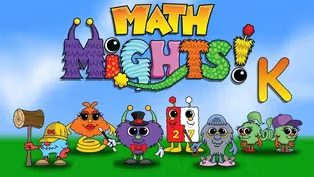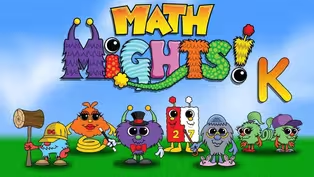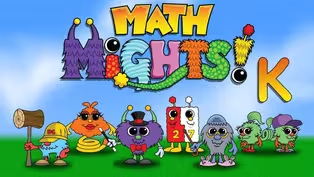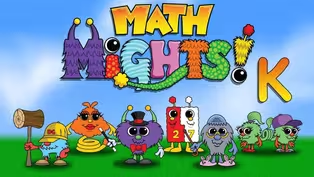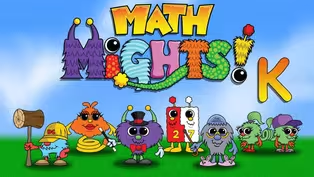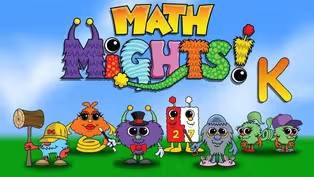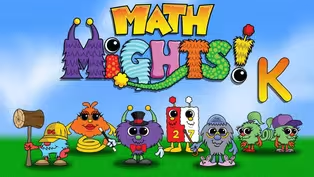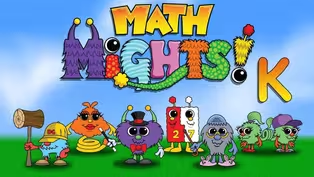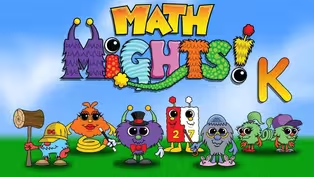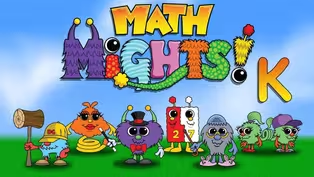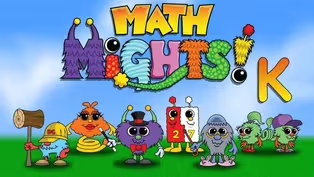Math Mights
Break apart pattern block designs
Season 3 Episode 305 | 15m 59sVideo has Closed Captions
Join Mrs. Gray for a word problem with Professor Barble!
Join Mrs. Gray for a word problem with Professor Barble! Next ready to have some fun with pattern block designs as we match expressions to two parts.
Problems playing video? | Closed Captioning Feedback
Problems playing video? | Closed Captioning Feedback
Math Mights is a local public television program presented by Detroit PBS
Math Mights
Break apart pattern block designs
Season 3 Episode 305 | 15m 59sVideo has Closed Captions
Join Mrs. Gray for a word problem with Professor Barble! Next ready to have some fun with pattern block designs as we match expressions to two parts.
Problems playing video? | Closed Captioning Feedback
How to Watch Math Mights
Math Mights is available to stream on pbs.org and the free PBS App, available on iPhone, Apple TV, Android TV, Android smartphones, Amazon Fire TV, Amazon Fire Tablet, Roku, Samsung Smart TV, and Vizio.
Providing Support for PBS.org
Learn Moreabout PBS online sponsorshipMore from This Collection
Video has Closed Captions
Join Mrs. Gray for a subtraction word problem with Porfessor Barble! (15m 52s)
Video has Closed Captions
Join Mrs. Gray for a subtraction word problem with Porfessor Barble! (15m 59s)
Video has Closed Captions
Join Mrs. Gray for a subtraction word problem with Professor Barble! (15m 59s)
Video has Closed Captions
Join Mrs. Gray for a subtraction word problem with Professor Barble! (15m 59s)
Compose & Decompose Numbers to 9
Video has Closed Captions
Join Mrs. Gray for a word problem with Professor Barble! (16m 1s)
Video has Closed Captions
Join Mrs. Gray for a word problem with Professor Barble! (15m 59s)
Addition & Subtraction Expressions
Video has Closed Captions
Match fun story problems with the correct addition or subtraction expression. (16m 15s)
Video has Closed Captions
Join Mrs. Gray for a word problem with Professor Barble! (15m 59s)
Subtraction with Word Problems Part 2
Video has Closed Captions
Join Mrs. Gray & Dotson for a Numeracy Talk with My Counting Buddy Junior! (16m)
Video has Closed Captions
Join Mrs. Gray & Dotson to talk about numbers with My Counting Buddy Junior! (16m)
Addition Word Problems with Quick Draws
Video has Closed Captions
Join Mrs. Gray for Numeracy Talk with Dotson working on conservation to 10. (16m)
Providing Support for PBS.org
Learn Moreabout PBS online sponsorship(upbeat music) - [Children] Math Mights.
- Hi kindergarten Math Mights.
Thanks for joining me today.
I'm so excited to do math with you.
My name's Mrs. Gray and I'm the kindergarten Math Mights teacher.
Today, we're going to be doing a word problem with our friend Professor Barble.
We're also going to be breaking apart pattern block designs.
Get ready.
Here comes our friend, Professor Barble.
(upbeat music) Professor Barble is an adventurer.
He wears a hat.
His hat is his thinking cap.
On the top of his hat comes a pole and on the top there are four arrows.
Those four arrows help remind Professor Barble to stop when he comes to a word problem, then he needs to think about what direction he needs to go.
Professor Barble has a tricky word problem for us to try today.
We are gonna be doing our word problem on our Kindergarten Journal Template.
This will help us slow down and try to remember each part of the problem.
Let's take a closer look at what our word problem is for today.
First, I will read it and then you will read it after me.
We're gonna be adding chunks in.
The chunks help us separate the different parts of information that we can find in the word problem.
Here we go.
John made a paperclip chain.
He put on five large paperclips.
This is where we're gonna add our first chunk because we got our first piece of information.
Let's keep going.
Then, he put on three small paperclips.
Let's add the chunk.
How long is John's paperclip chain?
Let's add the last chunk of information.
Now let's look at the sentence form so we know what we're trying to find in our word problem.
The sentence form says, John has hmm, paperclips on his chain.
Remember, when we see the line we go, hmm, because right now we don't have any answer to put there.
We're gonna figure it out during our word problem.
Now we're gonna go to our work mat and we're gonna build the work problem.
John had five large paperclips, one, two, three, four, five.
John, then added three small paperclips.
Let's add them on our mat, count with me.
One, two, three.
How many paper clips were on John's chain?
Can you count with me to find out?
One, two, three, four, five, six, seven, eight.
There were eight paperclips.
Now let's do our Quick Draw to show that.
Remember, when we do a Quick Draw, we're just going to do quick circles to show our thinking.
There were five large, one, two, three, four, five.
There were three small paperclips, one, two, three.
All together, there was eight.
Now let's take our thinking and we're going to put it on an organized 10 frame.
There was five large paperclips and then there was three small paperclips.
We can take that information and make a number bond.
The first piece was five for the five large paperclips.
The second part was three for the three small paperclips.
When we have five and three and we put them together, that means we had eight.
You're doing a great job.
Let's keep going and make our number expression to match.
Five plus three equals eight.
Let's go back to that sentence form and see if we can fill in the missing number.
John has, hmm, paperclips on his chain.
Well, we know that John had eight.
Wow, kindergarten Math Mights, you did a great job.
Now let's take a look at our, I can statement for today.
I can compose and decompose numbers up to nine.
In the drawings, I want you to think about which one doesn't belong.
That means, which one do you think is different from the others?
Hmm, I had a little trouble with this so I asked for two of my friends to help me and tell me what they saw.
Our friend Ronan and Damien have come to share their ideas today.
Ronan thought that letter A didn't belong.
He said that A didn't belong because it's the only one that didn't have six shapes.
Let's take a closer look at our mat to see what Ronan saw.
Ronan saw that in letter A, there was seven shapes.
Letter B had six shapes, letter C also had six shapes and letter D also had six shapes.
I see Ronan's thinking, letter A was the only one that didn't have six.
Damien had another idea.
Damien said that letter B doesn't belong.
He said it doesn't belong because it's the only one that didn't have squares.
Let's take a closer look to see Damien's thinking.
Damien noticed that in letter A, letter C and D there were squares but in letter B, there was no squares.
They have some more ideas to share.
Ronan also thought that maybe letter C didn't belong.
He said that letter C didn't belong because it's the only one that doesn't have the squares together.
Let's take a closer look at what Ronan meant.
Ronan saw that in letter A, there was squares but they were all next to each other.
Letter D also had the squares and they were all next to each other.
Letter C has squares, but look, they're far away, they have some diamonds in between.
I see what Ronan was talking about.
Let's see what Damien has to say.
He also thought that maybe letter D didn't belong.
He said letter D didn't belong because it's the only one that is not organized.
Let's take a closer look at what he meant.
When we look here, all of the shapes are nicely laid out together.
Letter B has them laid out in two lines.
Letter C also has them laid out in vertical lines and letter D, well, they're kind of all just spread out.
Hmm, which one did you think didn't belong?
Depending on which way you look at it, you could make an argument that any of them might not have belonged with the others.
We were having so much fun with pattern blocks, we're gonna keep using them in math today.
We're gonna be doing an activity called Pattern Block Design.
And in this design, you're going to use seven pattern blocks.
Our friend Ronan and Damien came back and they use pattern blocks using seven of them to build a picture.
Let's take a look at what Ronan created.
Ronan made a house today.
He used three green triangles and four orange squares.
He was able to write the number sentence to match, saying three plus four.
Let's take a look at what Damien created.
Damien also used seven.
He created a castle.
He used five orange squares and two green triangles to make his picture.
Let's take a closer look at both of them to see what we can notice is the same and what might be different.
Down here, I have the castle and the house.
Well, I noticed that in this one there was seven and also in the house there was seven.
Both the castle and the house used seven of the pattern blocks to create it.
But they were created differently using different numbers of squares and different numbers of triangles.
Let's see what we did.
We had in Damien's castle, two triangles.
I'm gonna write that out.
Two were green triangles, and in Ronan's house there was three green triangles.
Looking at our orange squares now, we can see that they also use different numbers.
Going to the castle, there was five of the orange squares.
I'm gonna write plus five because we're going to be adding them together to see how many pattern blocks.
Let's take a look at the orange squares for the house.
In the house they used four orange squares.
We're gonna write plus four.
Both the house and the castle, we know we had to use seven pattern blocks.
So we can write that both of the expressions equaled seven.
Equals seven, and three plus four equals seven.
So both pictures used seven total pattern blocks but they were broken up into two separate number pairs.
Great job, Math Mights, you were able to help me figure out what was the same and different with those pattern block designs.
We're gonna keep going with pattern block designs and see what Han made.
Han used eight pattern blocks.
Using the pattern blocks, he made some different design pictures.
In the first picture, he used five green triangles and three red trapezoids.
Let's put that in our number bond.
There were five green triangles and three red trapezoids.
If we put five and three together that means there was eight.
Using the pattern blocks, he made another design.
He was able to make a star, let's look at the star that Han made.
Han made a star using two red trapezoids and six green triangles.
Let's put that in our number bond.
Two red trapezoids and six green triangles.
When you take two and six and put them together that means there was eight.
Using those pattern blocks, he was able to make another design.
He made a rocket ship.
Let's look closer at the rocket ship that Han made.
Han used three green triangles and he used five red trapezoids.
Let's put that in our number bond.
He used five red trapezoids and three green triangles.
When you put them together, that means that there was eight.
After Han made the three different pattern block designs, he was asked to write the expression.
He wrote five plus three for all of them.
Let me write that.
He thought five plus three matched each of the pictures.
What do you think?
Do you agree with Han or do you disagree?
Let's take a look at what our friend Ronan thought.
Ronan said that he disagreed.
He did not think that five plus three matched each of the designs.
He said that five plus three only match the boat design and the rocket ship.
Let's take a closer look at our number bonds to see what we think.
Looking at our first number bond, we have five and three make eight.
We would write that as five plus three equals eight.
Looking at our star number bond, we have two for the two trapezoids and six for the green triangles.
We add two and six made eight.
We would write two plus six equals eight.
Let's take a look at our rocket ship design to see what expression we would write.
Looking here we have the five red trapezoids and the three green triangles to make eight.
That one would also be five plus three equals eight.
I think that I agree with Ronan.
The picture in the middle for the star does not match five plus three, that one would be two plus six equals eight.
Wow, Math Mights, you did a great job today.
Now it's your turn to be able to match expressions to the pattern block designs.
I hope you had a great time doing math with me today and I will see you soon.
(happy music) - [Boy] Sis4teachers.org.
(tab whooshing) - [Girl] Changing the way you think about math.
- [Woman] This program is made possible with funding from the Michigan Department of Education, Governor's Education Emergency Funds, the state of Michigan and by viewers like you.
(upbeat music)


- Home and How To

Hit the road in a classic car for a tour through Great Britain with two antiques experts.










Careers that Work

Support for PBS provided by:
Math Mights is a local public television program presented by Detroit PBS
